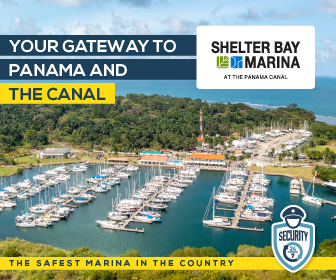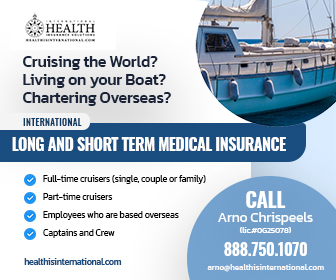Chesapeake Bay to St. Maarten: Atlantic 57 Catamaran capsizes
In late November on passage from the USA to St. Maarten, the Atlantic 57 Catamaran “Leopard” was capsized about 400NM north of the Dominican Republic. Very, fortunately, the three crew members were all rescued by a merchant vessel about 10 hours post capsize. One crew was badly bruised but the injuries overall were not severe. Quite how the to capsize happened is somewhat mysterious.
Published 8 years ago, updated 5 years ago
This report was taken from the boat designer’s website – https://chriswhitedesigns.com/leopard-capsize
The circumstances of the capsize are at once very clear and yet somewhat mysterious. There were three experienced, awake and alert sailors onboard who all have vivid impressions of the event.
Leopard’s daily progress south had been similar to a trough ahead of an approaching cold front which meant that the wind was southerly and conditions somewhat unsettled. True wind speeds were running in the 23-28 knot range.
The forecast was for the front to overtake Leopard and the wind to shift to the west, so the crew was intentionally sailing slowly so they could obtain better conditions behind the front. There was no desire to sail fast and further away from the approaching favorable wind. The time was 1900, which means dark in November, and dinner prep was underway in the galley.
Leopard had the second reef in the mainsail and the smaller self-tacking jib rolled to a #2 reef position. They were on starboard tack on a heading of about 150 degrees making about 7 knots in the puffs and much less in the lulls.
Professional captain Charles Nethersole has 14 years experience on the Atlantic 55 and 57 cats as well as decades of delivery and racing experience on a variety of offshore yachts. While he knows how t0 push a boat hard when it’s required, he is also very good at throttling back when conditions warrant.
Charles had just altered course a little further off the wind and eased the sheets to near luffing in order to make work in the galley more comfortable in the head sea conditions. A few minutes later, he was back inside the pilothouse standing next to the helm station when he heard a sudden loud roar and immediately the boat started to rotate. He had no time to even hit the autopilot- off button.
Cooking dinner in the galley, Carolyn reported that she heard a loud roar coming from the starboard quarter. She stopped what she was doing to listen – wondering what it could be – before she was thrown against the refrigerator as the boat rotated. Crewman Bert recounts that the capsize felt like “something supernatural”. Charles says that Leopard never took off forward as a fast cat typically would in the first seconds of a squall. She was immediately slammed into a sideways rotation.
Within a minute of capsizing Bert swam out towing the still uninflated life raft and pulled himself onto the partially immersed underwing. He reports that the wind was normal at that point with no rain or indications of unusual weather.
It is still early in our evaluation of what happened but my own opinion is that Leopard was overtaken by a tornadic waterspout. When sailing offshore, I have seen at least a hundred of these small tornadoes extending down from clouds. Mostly they are short-lived and don’t extend to the surface, at least in a visible form. But some do. And these can vary in intensity from small “dust devil” winds to an EF2 tornado (135 mph wind) with diameters of a few feet to 100 yards. This is the best explanation that I can come up with that fits the facts as we currently know them; a) Leopard was close to an approaching cold front, b) There were no rain squalls in the area, c) the roar, and d) the suddenness of the huge wind increase and the lack of strong wind immediately post capsize.
A capsize could be caused by a microburst from a thunderstorm or large squall. These can be violent and dangerous. But approaching squalls are normally visible, even at night and even when they don’t have lightning. And in my experience, even the worst ones have something of a “ramp up” phase where the first guests may be strong but nowhere near enough to immediately capsize a large catamaran with deeply reefed sails. I’ve had my own share of surprises and scares with squalls but in every case, I knew it was coming at least some large fraction of a minute before the big wind hit, and in most cases for 10 or 20 minutes. Unless you’re single handing and asleep there is always some time to react. It doesn’t take more than 3 seconds to step out of the A57 pilothouse and reach the mainsheet, I have timed it. And squalls don’t start and end in seconds.
Of course, we will examine and evaluate everything that we can in order to better learn what happened and how to possibly avoid it happening again. It is also imperative to closely examine the events post capsize in order to learn what we can so that everyone sailing offshore can be as well prepared as possible.
On the bright side, the EPIRB signal was quickly picked up and a US Coast Guard C-130 aircraft dispatched within a few hours of capsize to locate the distress call. Once Leopard was located, a nearby ship, the M/V Aloe, was directed to pick up the crew. This is a very difficult and potentially dangerous maneuver and was handled expertly by Captain Allegre and his crew. All of us are incredibly grateful for their capable assistance.
Leopard will be missed by all who had a hand in her creation as well as those who sailed her. And certainly most of all by her owners who enjoyed many cruises with family and friends over the eight years that Leopard was part of their family. It is a difficult loss.
However, the owner’s sentiments echo mine when he wrote:
“Notwithstanding what I can only consider a freak accident, I continue to have great confidence in the design. There is nothing wrong with the boat. All of us who go to sea have to be aware that there is always some risk, however well prepared we are and however careful. There is always a situation bigger than any boat. I’m afraid this was it.
Good preparation, the calm behavior of the crew under incredibly difficult circumstances, and of course the great work of the USCG and the M/V Aloe prevented this painful situation from being much worse.”
The following link also has interesting information about this capsize:
http://www.wavetrain.net/news-a-views/764-atlantic-57-capsize-more-details-on-the-fate-of-leopard
Related to following destinations: Dominican Republic, St. Martin, USA
Related to the following Cruising Resources: Caribbean Sea, Routing, Safety and Medical








An update re. the overturned hull being found was posted on CarolinaCoastOnline.com (link: http://m.carolinacoastonline.com/news_times/article_b9eb0c8e-306a-11e7-bcaf-0fc78fc0b127.html?mode=jqm)
In brief:
The catamaran was located by a fisherman on Wednesday off Cape Lookout National Seashore, roughly 25 miles off the Cape. The Authorities were alerted. The vessel was recovered by Sea Tow Crystal Coast and brought to Beaufort. The owners and insurance company were contacted.